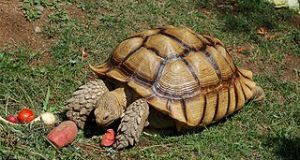 Some of the most popular semi-aquatic (or “basking”) pet turtles, such as Red-Eared and Yellow-Bellied Sliders, Map Turtles, Cooters and Chicken Turtles, eagerly accept fish and other animal-based foods – so eagerly, in fact, that it is easy to forget that most are omnivorous, and not carnivorous, by nature.
Some of the most popular semi-aquatic (or “basking”) pet turtles, such as Red-Eared and Yellow-Bellied Sliders, Map Turtles, Cooters and Chicken Turtles, eagerly accept fish and other animal-based foods – so eagerly, in fact, that it is easy to forget that most are omnivorous, and not carnivorous, by nature.
Natural Dietary Shifts
In the wild, the world’s most popular pet turtle, the Red-Eared Slider, starts life as a meat-eater but consumes ever more aquatic plants as it matures. By adulthood, vegetation forms the bulk of the diet, although this varies a bit among populations (Red-Eared Sliders are, after all, the most adaptable of all turtles, with introduced populations thriving on every continent save Antarctica!). The same applies to the various Painted Turtles (Eastern, Midland, Southern, Western), the Chicken Turtle and the Cooters – as they mature, over 90% of the diet may be comprised of plants.
Map Turtles vary by species and population as regards their diet – most consume more plants as they mature, but tend to remain largely carnivorous. Some Map Turtles exhibit unique strategies. For example, female Barbour’s Map Turtles (Graptemys barbouri) are specialized predators of crayfishes, clams and snails, while the much smaller males take insects, carrion and plants.
Captive Diets
Many commercial Aquatic Turtle Diets provide excellent nutrition and can serve as a dietary mainstay, and there is some evidence that diet of Reptomin and Freeze Dried Krill meets all the nutritional needs of several species.
However, I’ve always found it preferable to include a good amount of whole, natural foods in turtle diets, especially where less well-studied species are concerned. The shift from animal-based to plant-based foods is a very definite phenomenon in nature, and may very well hold the key to captive longevity and reproduction for some types of turtles.
Further Reading
An interesting study of the diets of wild Red-Eared Sliders and River Cooters is posted here.
Even baby Sliders will take greens, as this YouTube video shows.
Southern Painted Turtle image referenced from wikipedia and originally posted by Aka
 That Reptile Blog – Reptile, Amphibian and Exotic Pet Care and Information
That Reptile Blog – Reptile, Amphibian and Exotic Pet Care and Information


